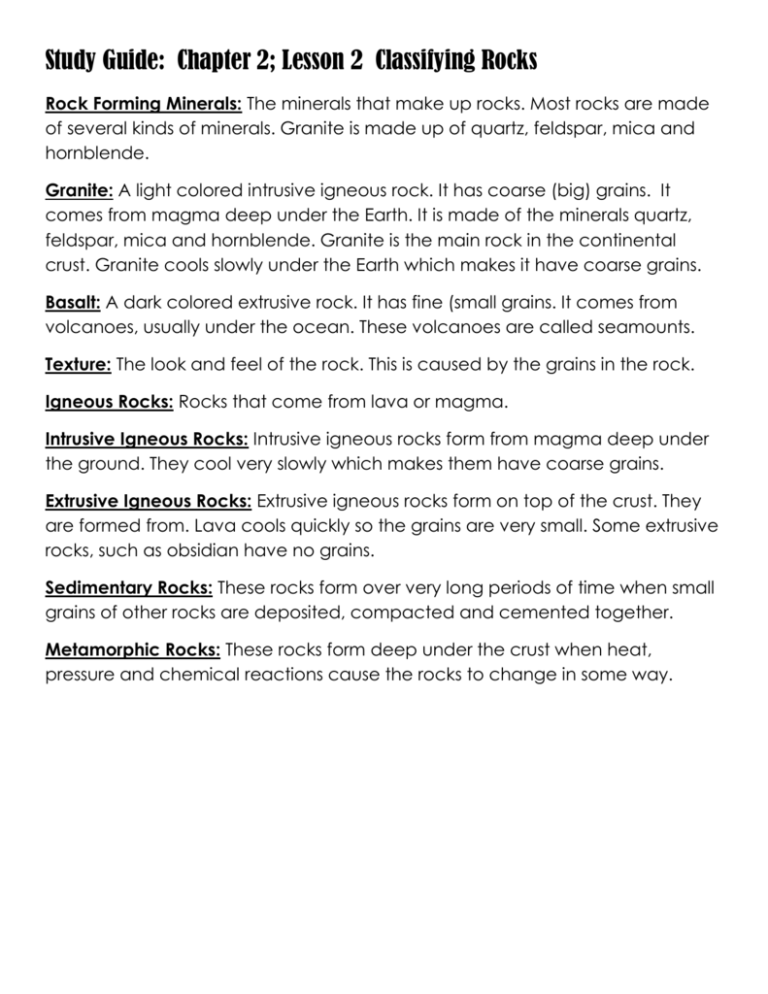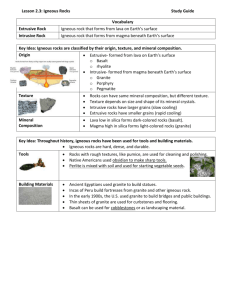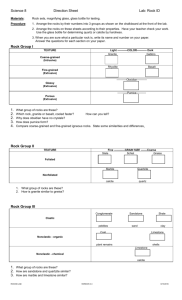Study Guide for Chapter 2
advertisement

Study Guide: Chapter 2; Lesson 2 Classifying Rocks Rock Forming Minerals: The minerals that make up rocks. Most rocks are made of several kinds of minerals. Granite is made up of quartz, feldspar, mica and hornblende. Granite: A light colored intrusive igneous rock. It has coarse (big) grains. It comes from magma deep under the Earth. It is made of the minerals quartz, feldspar, mica and hornblende. Granite is the main rock in the continental crust. Granite cools slowly under the Earth which makes it have coarse grains. Basalt: A dark colored extrusive rock. It has fine (small grains. It comes from volcanoes, usually under the ocean. These volcanoes are called seamounts. Texture: The look and feel of the rock. This is caused by the grains in the rock. Igneous Rocks: Rocks that come from lava or magma. Intrusive Igneous Rocks: Intrusive igneous rocks form from magma deep under the ground. They cool very slowly which makes them have coarse grains. Extrusive Igneous Rocks: Extrusive igneous rocks form on top of the crust. They are formed from. Lava cools quickly so the grains are very small. Some extrusive rocks, such as obsidian have no grains. Sedimentary Rocks: These rocks form over very long periods of time when small grains of other rocks are deposited, compacted and cemented together. Metamorphic Rocks: These rocks form deep under the crust when heat, pressure and chemical reactions cause the rocks to change in some way. Chapter 2; Lesson 3: Igneous Rocks Intrusive Igneous Rocks: Rocks that form from magma deep under the ground. Intrusive rocks cool very slowly so have coarse grains and large crystals. Granite is the most common intrusive igneous rock. Granite is coarse grained and light colored. Extrusive Igneous Rocks: Rocks that form from the lava from volcanoes. Extrusive rocks cool very quickly so they have fine small grain sizes. Basalt is a fine grained dark extrusive igneous rock that comes from volcanoes, especially seamounts, which are volcanoes under the ocean. Volcanic Glass: These rocks lack a crystal structure and have no grains. They come from volcanoes on land. Obsidian is an example of volcanic glass. Uses: People throughout the world have used igneous rocks for tools and building materials because they tend to be dense, hard and very durable. Pumice is an extrusive igneous rock that comes from volcanoes. It has lots of air pockets which cause it to have a coarse rough feel. Pumice is used an abrasive for cleaning and polishing. Chapter 2; Lesson 3: Sedimentary Rocks Sedimentary rocks form from sediment which are small particles that come from other rocks or living things. They form when sediment is deposited by wind or water. 4 steps to form sedimentary rocks: 1] weathering / erosion 2] deposition 3] compaction 4] cementation Weathering: The effects of freezing, thawing, plant roots and other forces on rocks. These forces break rocks into small particles called sediment. Erosion: Wind or water carries the small particles, or sediment, away after it is weathered. Erosion can also occur by ice carrying particles away. This happens when glaciers move. Deposition: Material that is laid down in a certain area in many layers over a long period of time. The materials settle out of the wind or water that is carrying it. Compaction: Layers of deposited sediment are squeezed tightly together. Newer layers put a lot of weight on older layers causing it to compact even more. Cementation: Dissolved minerals crystallize and glue particles of sediment together. Clastic Rock: A sedimentary rock formed when rock fragments are squeezed together. Examples of clastic rock are shale, sandstone, conglomerate, and breccia. 1] Shale: forms from tiny particles of clay. This is a very fine grained rock. 2] Sandstone







